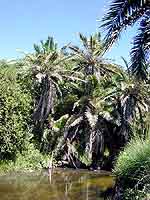View crop
View crop Data sheet EcoPortPhoenix reclinata
 |
|
| Notes |
|---|
| DESCRIPTION: It is an evergreen palm reaching 10-12 m in height. Stem about 25 cm in diameter, may be straight or curved, sometimes swollen at the base, with a dense mass of pencil-thick roots arising from the lower part. Crown consists of 15-30 live leaves, of these 10-20 are dead and dying ones. Fruits borne in large, drooping bunches, individual fruit oval, orange to reddish- or yellow-brown, up to 2.5 cm long, fleshy, datelike with a rather insipid but edible flesh. USE: Buds may be eaten raw or cooked as a vegetable. The heart of the crown is eaten, and the fruit is also edible. Leaves are eaten by elephants, and the fruit is food for many wild animals. Wood is used as charcoal, the leaves yield fibre and dye and the roots tannin. It is planted for erosion control and can be very effective if planted as a specimen tree on a lawn, to line the sides of a road or to fill a large opening in a large garden. GROWING PERIOD: Perennial. COMMON NAMES: coffee palm, wild date palm. FURTHER INF: It is a clump-forming palm, it may be solitary but is usually found growing in colonies. Grows throughout tropical Africa in humid lowland woodlands, highland forests and on open, rocky hillsides. Occasionally it grows in grasslands with a high water table. Throughout Zambia the species is essentially a swamp or riverine species and is found in considerable concentrations around Lake Bangweulu. It is also found around anthills, on boggy dambos, in munga woodland on the Kafue Flats and in the Kalahari woodland. Outside Zambia its range extends from Senegal across West Africa to Ethiopia, and over the whole of eastern and central Africa to Botswana and the Cape. It is drought resistant and prefers full sun but also thrives in light shade. It is a protected species in South Africa. | Sources |
| SOURCE: ICRAF Agroforestree Database (28.06.02) E8524 |